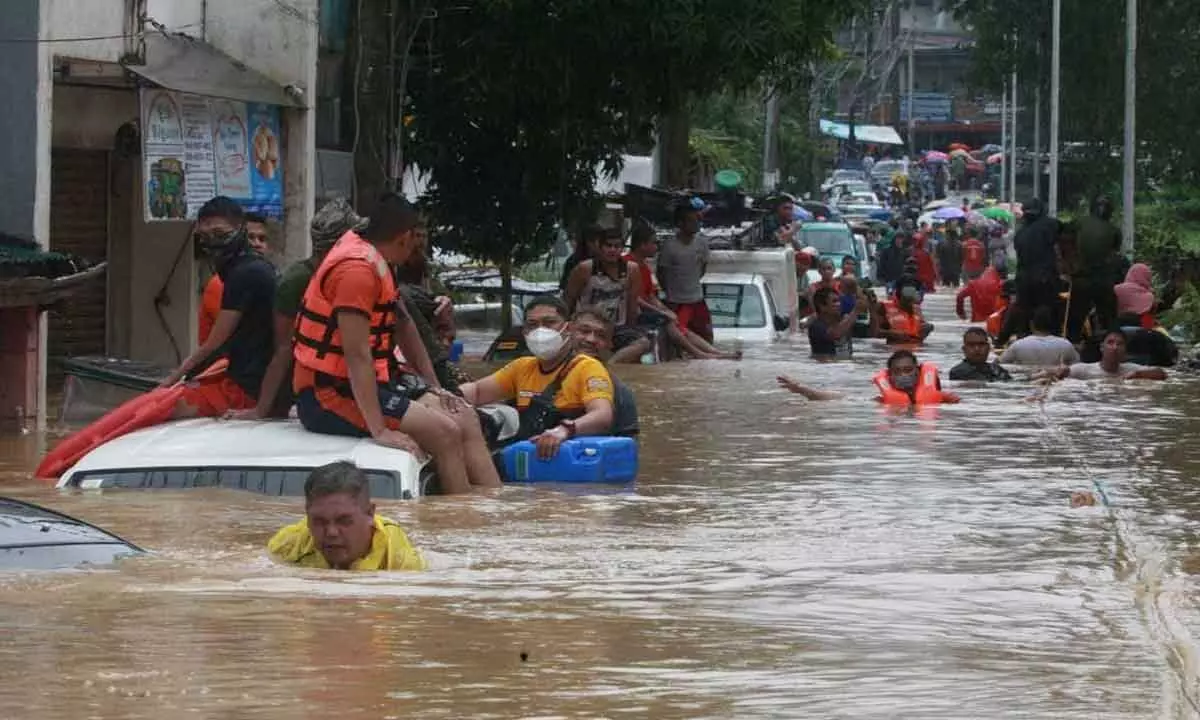Live
- Over 7,600 Syrians return from Turkiye in five days after Assad's downfall: minister
- Delhi BJP leaders stay overnight in 1,194 slum clusters
- Keerthy Suresh and Anthony Thattil Tie the Knot in a Christian Ceremony
- AAP, BJP making false promises to slum dwellers for votes: Delhi Congress
- 'Vere Level Office' Review: A Refreshing Take on Corporate Life with Humor and Heart
- Libya's oil company declares force majeure at key refinery following clashes
- Illegal Rohingyas: BJP seeks Assembly session to implement NRC in Delhi
- Philippines orders full evacuation amid possible volcanic re-eruption
- Government Prioritizes Welfare of the Poor, says Dola Sri Bala Veeranjaneyaswamy
- Two Russian oil tankers with 29 on board damaged due to bad weather
Just In
Loss & damage fund: Whither key info?


The new climate fund board is mandated to hold its first meeting by January 31, 2024. While this early start time is laudable, droughts will continue killing crops, and storms will continue flooding homes while the new fund engages in another series of meetings to determine who will qualify, how they can apply and how and when funds will actually be dispersed
While any deal on funding for climate disaster damages was sure to be portrayed as a historic win, further investigation suggests that it should be welcomed with hesitation and scrutiny. First, the fund contains no specifics on scale, financial targets or how it will be funded. Instead, the decision merely “invites” developed nations to “take the lead” in providing finance and support and encourages commitments from other parties. It also fails to detail which countries will be eligible to receive funding and vaguely states it would be for “economic and non-economic loss and damage associated with the adverse effects of climate change, including extreme weather events and slow onset events.”
So far, pledges have been underwhelming.
Calculations of early commitments total just over US$650 million, with Germany and the United Arab Emirates pledging $100 million and the U.K. committing $75 million. The United States, one of the largest climate change contributors, pledged only $17.5 million in comparison. It’s a shockingly low starting point.
Also, any notion that this fund represents liability or compensation by developed countries — a major concern for countries with long histories of carbon pollution — was removed entirely. It in fact notes that loss and damage response is based on cooperation instead.
In a rare win for the developing world, funds were made available — even at subnational and community levels — to all nations, though with yet-undetermined performance indicators. Additional concern has been raised about the fund’s interim host – the World Bank. In fact, deciding on a host institution was one of the sticking points that nearly derailed earlier talks.
On one side, the United States and other developed nations insisted the fund be hosted by the World Bank, which has always been led by an American and has historically spread pro-Western policies. Developing countries, however, resisted the World Bank’s involvement based on their historical experiences with its lending and structural adjustment programs and noting the bank’s role for years in financing oil and gas exploration as cornerstones of development efforts.
Following a stalemate and US attempts to block a consensus, a compromise was reached to host the fund under the World Bank for four years, with guardrails to ensure its independence and impact. After this window, the host structure will be reviewed, leading to either a fully independent fund or continuation under the World Bank. The concern for critics with this route is that the compromise risks ending up as a permanent hosting situation.
And there are more issues, such as the fund board’s composition, which only allows for national representatives, not civil society representatives such as from Indigenous groups, as developing countries requested. The scope of funding that will be allowed is also still up in the air. In the fund’s vague state, it opens the door for countries, as part of their loss and damage funding commitments, to count private loans, conditional import credits and even funding from the fossil fuel industry at the same time the industry continues to fuel climate damage.
What happens next, starting in 2024
To date, the international climate community does not have a solid track record when it comes to climate finance promises. Each successive fund — from the Green Climate Fund that supports green projects in the developing world to the Adaptation Fund that builds climate resilience for the most vulnerable nations — has been woefully undersourced from inception. In 2021, the entire climate finance ecosystem, from national commitments to private investment, totaled $850 billion. Experts indicate that this sum needs to be closer to $4.3 trillion. That target represents 20% year-over-year growth until the end of this decade – a significant ramp up from recent years. From 2011 to 2020, total climate finance grew at just 7% annually. If this trend continues, not only will developing and most vulnerable countries lose faith in this process, but the very need for loss and damage funding will only grow.
The new fund board is mandated to hold its first meeting by January 31, 2024. While this early start time is laudable, droughts will continue killing crops, and storms will continue flooding homes while the new fund engages in another series of meetings to determine who will qualify, how they can apply and how and when funds will actually be dispersed. (Courtesy: The Conversation; Writer is Associate Professor of International Relations and Environmental Studies, USC Dornsife College of Letters, Arts and Sciences, Los Angeles, US; Researcher Will Erens, a student at the University of Southern California, contributed to this article)

© 2024 Hyderabad Media House Limited/The Hans India. All rights reserved. Powered by hocalwire.com






